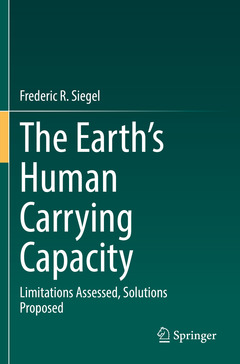The Earth’s Human Carrying Capacity, 1st ed. 2021 Limitations Assessed, Solutions Proposed
Auteur : Siegel Frederic R.

Chapter1.- Earth’s Human Carrying Capacity: The Basics.- Chapter2.- Water: A Limit On Our Earth’s Carrying Capacity.- Chapter3.- Food Security/Insecurity, Food Systems.- Chapter4.- Impact of Global Warming/Climate Change On Food Security 2020.- Chapter 5.- Sanitation: Waste Generation/Capture/Disposal Status 2020.- Chapter6.- Access To Natural Resources Not Water Or Food 2020.- Chapter7.- Global Warming And Water 2050: More People, Yes; Less Ice, Yes; More Water, Yes; More Fresh Water, Probably; More Accessible Fresh Water.- Chapter8.- Food 2050 - More Mouths To Feed: Food Availability and Access.- Chapter9.-Sanitation 2050.- Chapter10.- Natural Resources Beyond Water And Food 2020 To 2050.- Chapter11.- Economic Realities in 2020 Populations: What do they Portend for 2050? 2100?
Dr. Frederic R. Siegel is Professor Emeritus at The George Washington University. His books Applied Geochemistry (1974), Geoquimica Aplicada (1991), Natural and Anthropogenic Hazards in Development Planning (1996), Environmental Geochemistry of Potentially Toxic Metals (2001/2002), Demands of Expanding Populations and Development Planning (2008), Countering 21st Century Social-Environmental Threats to Growing Global Populations (2015), Mitigation of dangers from Natural and Anthropogenic Hazards (2016), Cities and Mega-Cities (2018), and Adaptations of Coastal Cities to Global Warming, Sea Level Rise, Climate Change and Endemic Hazards (2020) reflect Dr. Siegel’s cumulative teaching and research experience in theoretical and applied exploration and environmental geochemistry, and his work to alleviate or eliminate environmental problems related to physical, social, chemical, and economic conditions associated with planned development projects.
Focuses on the Earth’s carrying capacity to service the needs of its human populations and preserve ecosystems
Provides a realistic assessment of where the world is now with respect to global populations and what can be done to adapt to changes
Discusses how the COVID-19 pandemic has affected the world’s societies and how they have reacted
Date de parution : 08-2022
Ouvrage de 154 p.
15.5x23.5 cm
Date de parution : 08-2021
Ouvrage de 154 p.
15.5x23.5 cm
